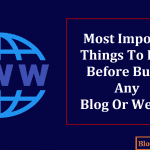Did you know that there are over 1.5 billion websites in the world today?
And according to Internet Live Stats, the 1.5bn mark was surpassed 2014. At the same time, the company notes that out of the 1.5bn websites registered, only 200 million websites are active at any particular time.
What this means is that there are millions of dormant websites, some of which have domain names up for grabs.
Note that the company defines a website as a unique hostname that can be resolved by using its name server to an IP address.
With millions of websites up and running and registered, it means that the domain name you’d like to use on your website is already owned and used by someone else.
The good news is that this is not always the case and in most cases, you might find that the current owner of the domain name is willing to let go the domain name.
And, this comes with its perks; among them the fact that the domain name might be trusted by search engines, increasing the chances of you running a successful website.
But, there is one catch: the pre-owned domain could come with detrimental effects on all the efforts you’ve put into SEO.
Therefore, you must undertake your due diligence.
Though appealing, that domain name could have changed hands multiple times which will not only make the search for its history impossible, but it could also mean taking over some bad rapport from the domain name, consequently presenting you in bad taste to the search engines.
In the worst-case scenario, the domain name you are interested in could have attracted a warning or a penalty from Google rendering your purchase a costly mistake.
We don’t want anyone to go through any of this hence this guide on the things you should consider before you buy a pre-owned domain name.
Let’s jump right into the things you should do and evaluate before you buy a domain name owned by someone else.
Contents In Page
1. Domain Authority
The Domain Authority (DA) refers to a metric coined by Moz to predict a domain name’s or website’s ranking potential.
Normally, you’d expect the used domain name to have a high domain authority than your current site which means that you could easily rank on SERPs.
Unfortunately, your DA, though proprietary does not matter as much as backlinks which play a huge role in the growth of your DA score.
This implies that when you acquire a domain name whose DA is significantly lower than yours, you will be forced to put in so much more effort in rebuilding the site’s domain authority.
As long as the site has good backlinks and you have a great SEO strategy, the low DA shouldn’t stop you.
2. Analyze the health of the domain name using Google Search Console
Before you acquire that domain name, you should access the domain name’s Google Search Console account to analyze the name’s health.
For this, you have to find the credential for the account from the current account owner/ admin then request access to the account.
And if the name hasn’t been set up on Google Search Console, you could place your request for set up at this time.
After logging into the domain name’s Search Console, go to the Search Traffic button and select Manual Action to check whether or not the domain has penalties or warnings from Google.
You could also click on the Security Issues button for security issues such as Google suspecting that the website was hacked.
3. Check for abnormal patterns in traffic
If you can access the domain’s Google Analytics report (GA), you should look through the account, keenly observing any abnormal traffic patterns.
You can also use GA to determine if the domain received organic traffic from unusual URLs or not. Google Analytics will also help you search for referral traffic for determining whether or not the referral traffic was from spammy websites.
Without a GA account set up, you will not have critical information about the domain name, this check will be null and void, and you might buy a domain name that could sabotage your business.
Besides Google Analytics, you could also make use of Bing Webmaster Tools.
In this tool, go to the Site Security Section for alerts on malware, change of the SSL certificate, as well as phishing attempts.
Under the Page Traffic section in the Reports & Data main tab, you can assess the domain’s leading landing pages.
4. The Domain Name’s blacklist status
Most domain names are blacklisted when their history shows that the domain name was used to send spammy emails.
The spammy emails could further result in the blocking of the email server’s IP address.
5. Check the site’s indexation
This is an important feature of SERP analysis. For this analysis, you have to use the site search operator then run a Google Search.
The analysis could also help you check for any malicious or spammy landing pages within the SERPs.
The SERP analysis could also help your search because it allows you to add to the search operator by modifying your search.
For instance, you could replace the site’s domain name with red-flagged terms/ phrases like gambling, porn, or online games, among others.
Running this search is effective because Google displays warnings on the SERPs if it detects hacked sites.
Unfortunately, Google might fail to flag everything.
6. Check internal and external links for link manipulation
If you are looking for information on whether there has been a domain name misuse or not, look at link manipulation.
When a domain name is compromised, it will use specific anchor text or phrase too many times so that it can link to some other spammy content.
Unfortunately, link manipulation is harder to detect when dealing with smart hackers.
These hackers use elusive means which means that the anchor texts/ phrases do not change.
You could, however, go around this technicality by using Screaming Frog.
Screaming Frog allows crawling of a maximum of 500 URLs at no cost. Once you log into Screaming Frog, click in the Outlinks tab located at the bottom of the page.
This will show you the specific URL links the anchor texts point to.
And for the analysis of the external links, you could use Majestic or any other tool to obtain the domain name’s backlink profile.
The external linking analysis tools will also give you details of elements like the off-page factors like the referring domains.
The best bit is that you could get a little more granular and you could see the Top Level Domains that the backlinks come from.
If the backlinks come from one or even more sites, but disproportionately, it could mean that the domain uses the pay-to-play strategy for link acquisition, or worse, the site might have suffered from negative SEO.
7. Check the location citations
The location citation is the reference for your business name, address and phone number (NAP).
A citation refers to the times that your NAP details show up on someone else’s directory or website.
So, before you acquire a used domain name, ensure that you can identify every instance that NAP appears on a web page, then update the details.
8. The use of Anchor texts
Anchor texts’ usage represents one of the most overlooked off-page SEO factors, but it is crucial.
Generally, the anchor text refers to the word/ phrase hyperlinked to direct a user to another web page or website. They signal relevance to Google.
While wiping out every content so that the anchor texts redirect you to 404 pages is a smart move, links that point to a homepage not online with content is not a great thing.
You might want to contact the webmasters asking them to update or remove the anchor texts.
This is because when you have multiple sites linking to the domain you are interested in by using the location-specific anchor text, it could be a problem – you will be sending Google mixed signals.
Google frowns upon mixed signals.
9. Page Speed
The page speed is crucial in the determination of the site migration speed.
However, if you find that the domain name you are interested in is relatively healthy, and your current content management system, architecture, and domain are working well, you could still migrate.
All you need to do is to run regular CMS and website patches to detect and fix vulnerabilities, increasing your page speeds.
You could use Google PageSpeed Insights to test the page speed.
10. Web Hosting Location
The location of your web hosting provider’s servers will determine the performance of your website, as well as the general SEO performance.
With the IP address location shown to affect page speed, make sure your web host is as close to you as possible.
Bonus Tips
11. Avoid domain names with hyphens or numbers
12. Use Escrow services during the transfer
13. Go for a brandable name
14. Shop at a trustworthy domain registrar








